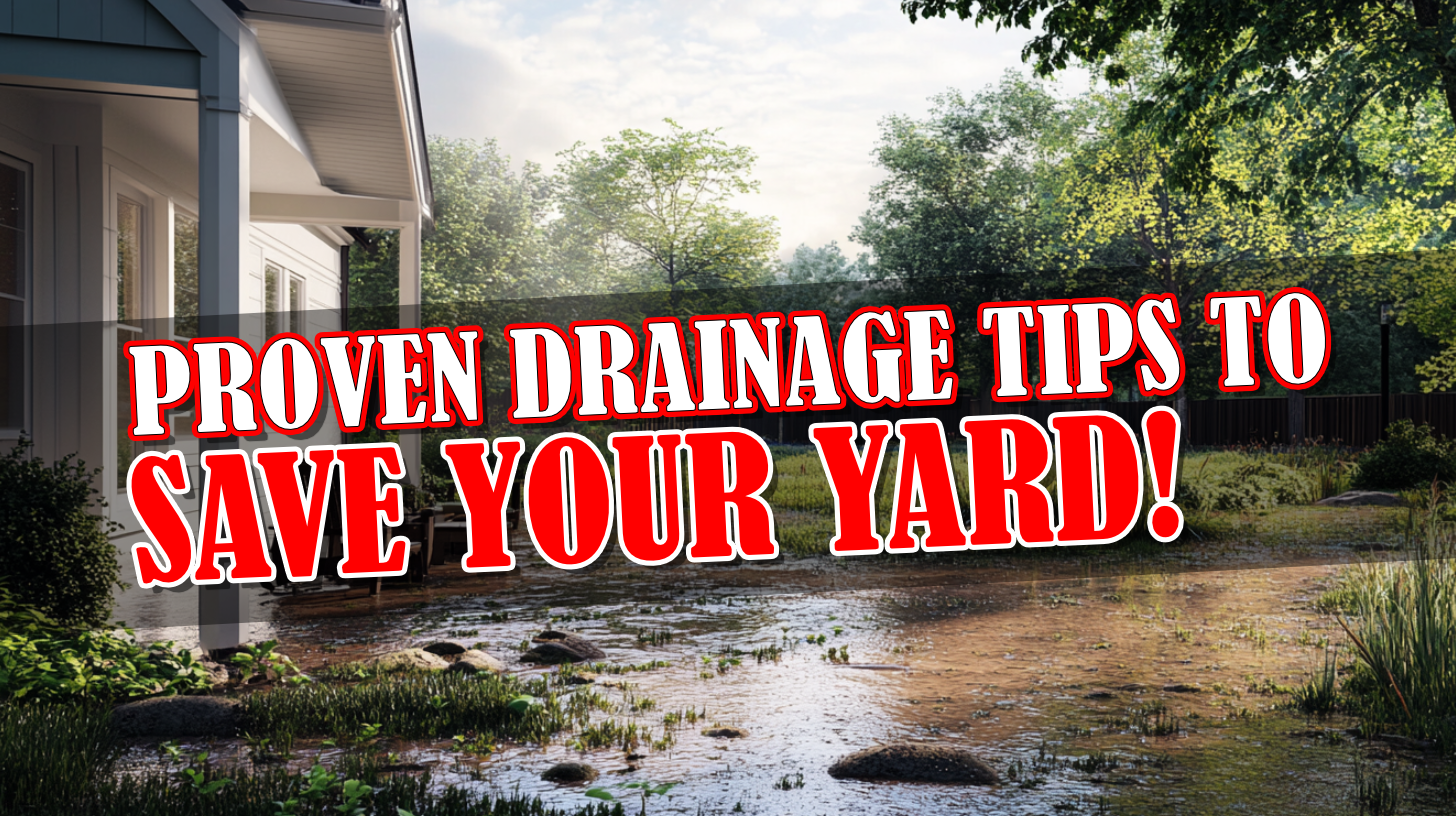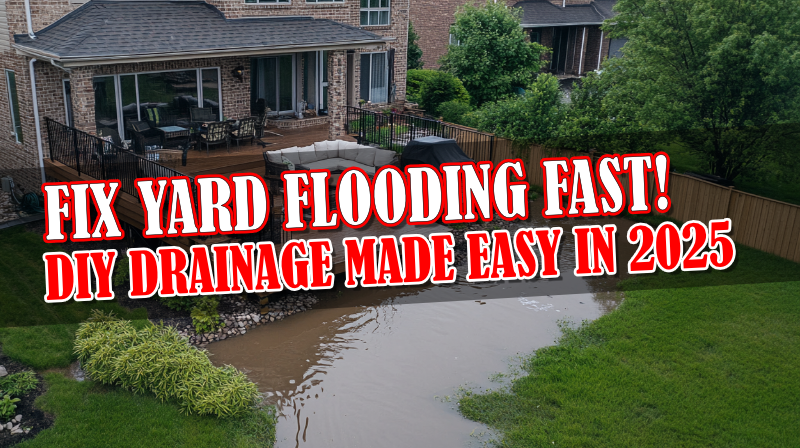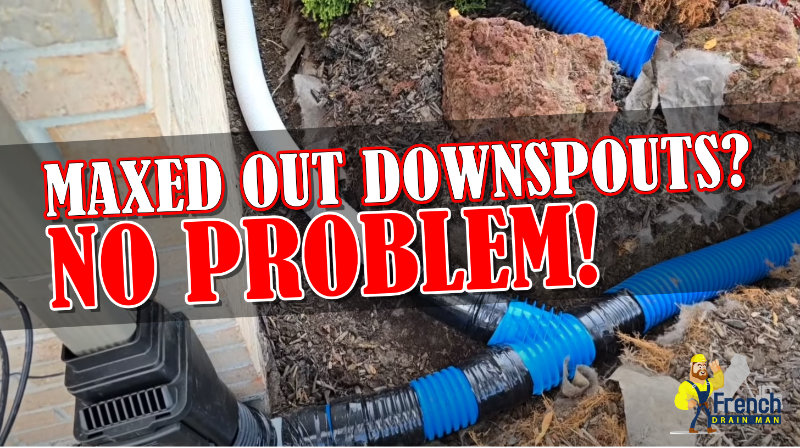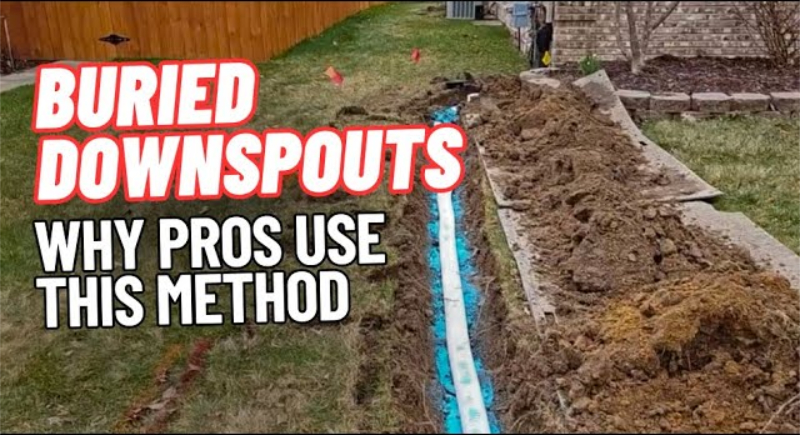
Homeowners installing French drains expect them to efficiently manage excess water, protecting their property from flood damage while keeping their landscape thriving. However, even the best-laid plans may encounter issues; understanding why a French drain could fail is crucial for prevention and repair efforts. In this article, we’ll look at common reasons for such failure—natural causes like clay soil or soggy lawns could trigger it, or structural issues with yard drains could wreak havoc. Practical insights and solutions will be offered here.
Incorrect Installation
One of the primary factors preventing French drains from working effectively is improper installation, which requires precise care regarding depth, slope, and component placement. Adequate depth and appropriate slope are essential elements for an efficient French drain. A trench should generally feature a minimum gradient of at least 1% (1 in 8 feet drop) to ensure adequate water drainage, with adjustments made according to local water tables and soil types – for instance, deeper trenches in areas with higher water tables or dense clay soils are typically deeper to allow sufficient drainage. An example would be when a homeowner reported pooling water even with an effective French drain installed, yet nothing seemed to drain correctly. An investigation revealed that their trench was only sloped at 0.5% and 6 inches shorter than necessary due to the clay soil prevalent in their region; after making these adjustments to meet standard recommendations for slope and depth adjustments, their drainage issue had been effectively solved.
Proper pipe placement is equally critical; optimal water capture and efficient drainage should be placed at the lowest point in each trench to maximize capture while supporting efficient drainage. Misplaced pipes can lead to ineffective drainage or even cause it to back up into a system, stressing its operation further. An illustration would demonstrate pipes installed correctly at the lowest part of a trench with all collected water flowing naturally to its outlet, in contrast with pipes laid too high or unevenly, which cause pools of water to pool without reaching any pipes.
Material selection is integral to ensuring the durability and efficacy of French drain systems. Utilizing quality double-punched geotextile fabric and appropriately sized gravel will help ensure they remain unclogged over time and ensure functionality. Double-punched fabric is particularly effective because it provides excellent filtration while allowing water to pass through, helping prevent soil build-up from clogging the gravel and pipes. Large, rounded gravel is often preferred over smaller or crushed stones as it allows water to move more smoothly through void spaces in pipes. Lower-quality fabric or gravel could quickly degrade and clog, necessitating costly repairs or complete system replacement sooner than planned.
Installation techniques are vital to ensuring a system’s effectiveness, such as using a sod cutter to remove and replace top layers of grass in an orderly fashion ensuring landscape appearance is preserved post-installation. Furthermore, regular monitoring and maintenance must also take place to avoid failure. Homeowners should inspect their French drains annually, looking for signs of sediment build-up or fabric degradation, performing clean-outs as necessary, or making necessary adjustments so the long-term functionality of their drain is ensured.
Clogging and Blockages
Roots from nearby vegetation are attracted to the moisture around a French drain, and over time, these roots can find their way into drainage pipes or the spaces between gravel beds, blocking water flow. This problem becomes severe if an inadequate barrier is used during installation – for instance, a double-punched geotextile fabric might lose its effectiveness at blocking roots – for example, in a garden setting where quickly growing plants and trees threaten its integrity by infiltrating its system with their roots.
Sediment build-up presents another formidable obstacle, particularly in areas with high silt content. Without sufficient filtration measures, such as adequately installed geotextile fabric and appropriately sized gravel, sediment can quickly enter the system without proper filtering, filling in all available voids between the gravel. Over time, this accumulation reduces a drain’s capacity to channel water away effectively. This problem becomes especially acute during heavy rainfall events when more soil erosion may take place and top layers become vulnerable to erosion.
Homeowners need to conduct regular maintenance to prevent clogs in their drains effectively. Homeowners should conduct inspections regularly to detect signs of root penetration or sediment accumulation and take corrective actions as necessary – this may involve cleaning out or replacing sections of compromised filter fabric, among other steps. When installing new drains, the trench must be lined with high-quality filter fabric and gravel to maintain adequate void space and prevent rapid compaction. These steps ensure the integrity and functionality of their drain while effectively protecting properties against water-related issues for as long as possible.
Environmental and External Factors
Environmental and external factors play a pivotal role in the performance and longevity of French drains, including climate variations, soil composition differences, nearby construction activities, etc. All can negatively influence its function.
Climate Impact
A French drain’s design must consider local climate patterns to function optimally. Heavy rainfalls can overload its system if it is not designed to effectively manage large volumes of water. At the same time, freezing temperatures could cause it to freeze up inside it and expand, potentially damaging pipes in its path. Therefore, it must consider these considerations during its design stage to ensure it will withstand local weather patterns and perform as intended.
Soil Composition
Soil composition is another critical consideration. Clay soils tend to absorb less water quickly, which may overburden a French drain during periods of heavy rain, while sandy soils provide superior drainage systems but may allow too much of it to pass quickly through, undermining their ability to redirect away from structures effectively.
Construction and Landscaping Changes
Construction or landscaping changes near a French drain may lead to its failure. For instance, a new building can alter landscape slopes unexpectedly, forcing water to flow towards it unexpectedly and overwhelming its system. Alterations that alter ground levels or introduce new sources like irrigation systems could compromise an existing French drain’s effectiveness and lead to its malfunction.
As homeowners seek to protect against environmental and external risks when planning and installing French drains, they must consider these during the design and installation of their French drains. Employing adaptive design features – deeper trenches or extra pipe in areas prone to heavy rainfall or freeze-thaw cycles can help accommodate these variable situations; additionally, regular assessments of property and surrounding area changes that could affect your drain are highly advised.
Design Considerations
Designing an effective French drain requires more than simply plugging it in and playing; it carefully considers several vital factors. Ignoring them or oversimplifying the design process could result in an undersized or ineffective system.
Customization to local conditions
French drain success hinges heavily on its design specifically tailored to the site. This involves taking into account soil type, topography, average rainfall levels, and water table level of an area; for instance, a French drain in heavy clay soil will need additional considerations like increased trench depth or extra filter layers, while one in sandy soil might prioritize stopping the rapid escape of water.
Over-relying on standard practices
Standard installation practices provide an adequate baseline, but relying solely on them without making adjustments for local nuances can result in underperformance or failure. Each property presents challenges – such as higher groundwater levels or unusual terrain slopes – which necessitate modifying traditional French drain designs accordingly.
Integrate Other Drainage Solutions
As French drains cannot provide comprehensive water management independently, additional drainage solutions such as sump pumps, catch basins, or surface drains may need to be integrated to achieve comprehensive water management and ensure all potential issues are addressed without overburdening a French drain. This holistic approach ensures all the potential problems are handled while protecting against possible overloading of its capabilities.
Integrating these design considerations into the planning and installation of a French drain can significantly increase its effectiveness and durability. Homeowners should work with experienced professionals who can assess their property’s needs before designing an effective drainage solution that fulfills them.
Preventative Measures
Preventing French drain failure requires regular maintenance and proactive measures that ensure it remains functional. This section offers homeowners practical guidance on how to keep their French drain working optimally.
Regular Inspections
Conducting routine home inspections is vital to recognizing potential issues before they escalate into more significant issues. Homeowners should schedule annual or biannual inspections after heavy rainfall or freeze/thaw cycles to check for signs of sediment build-up, root intrusion, pipe damage, or pipe corrosion. Such inspections could help identify issues that are easier and cheaper to rectify early.
Clean-Outs and Maintenance Services
Based on inspection findings, cleaning out or performing maintenance may require French drains to function optimally. This could involve flushing the system to flush away debris or sediment or more extensive repairs, such as replacing sections of pipe or fabric that have become compromised. Regular maintenance extends the drain’s lifespan and ensures it continues to perform as intended.
Adaptive Practices
Tailoring maintenance practices based on environmental changes or system performance observations is another effective way of avoiding failures. If, for instance, a homeowner notices their drain slowing down after certain weather events, this may indicate the need for more frequent inspections and adjustments to its design (for instance, increasing gravel size or adding extra pipes for handling higher water volumes).
Preventative measures taken by homeowners can significantly lower the risk of French drain failures and ensure that they remain an integral component of their drainage solution.
Technical Specifications
French drain effectiveness depends heavily on the quality and suitability of the materials used to construct it. Every component, from pipes to stones to fabric, ensures optimal drain function over time. Below, we detail which materials French Drain Man uses when building their drains.
Corrugated Pipe (High Octane)
French Drain Man constructs his French drains using 4-inch perforated corrugated drainage pipes made of HDPE. These pipes feature small perforations that allow water to enter through small holes. Choosing this diameter ensures sufficient flow capacity while making installation simpler; two of these pipes can often be laid side-by-side in trenches to increase the system’s capture capacity and redirection capability.
Stone (Round Rock)
French Drain Man utilizes large round rocks around pipes as part of its solution for adequate water flow and filtration. Their preference is a large-diameter round rock that leaves substantial void space around pipes—typically 1.5 inches in diameter—to protect interstitial spaces from becoming clogged with sediment, thus maintaining the integrity and functionality of the drainage system.
Geotextile Fabric (Double Punched)
French Drain Man employs high-grade geotextile fabric to prevent soil from infiltrating pipes and stones. This fabric is double-punched, non-woven, and porous enough to resist pressure from soil pressure and environmental conditions while filtering out sediment while still permitting water passage. This fabric helps filter out particles while permitting passage for drainage purposes without the risk of clogs limiting drainage performance.
Technical specifications must be strictly observed during French drain installation to ensure it meets or surpasses performance expectations, prevents drainage problems, and provides long-term effectiveness. Adherence to this standard ensures maximum effectiveness.
Long-term Care and Monitoring
One of the many hallmark benefits of The French Drain Man’s installation method is the low maintenance required over its lifespan. Due to the careful selection of materials and installation process, French drains from The French Drain Man are engineered to operate efficiently for years without regular upkeep requirements. Here is an overview of their care and monitoring strategies, which reflect this unique approach.
Minimal Maintenance Requirement
The French Drain Man offers an alternative approach to French drain installation. It employs double-punched geotextile fabric that encases pipes and gravel, shielding them from soil intrusion. Soil and roots are two familiar sources of clogging traditional French drains. As a result, sediment build-up or root damage risk significantly diminishes, and homeowners can rest easily knowing their French drain is designed as a long-term drainage solution.
Monitoring for System Integrity
Although regular maintenance may not be required, periodic checks on its integrity are still recommended, especially after extreme weather events like heavy rainfall or freeze-thaw cycles. Monitoring should focus on surface drainage patterns to ensure water continues to be diverted away from properties; any changes might indicate changes in landscape or unusual events rather than issues with the French drain itself.
Professional Inspection Recommendations
Homeowners seeking maximum peace of mind following significant landscaping or construction activities near their drain site should consider consulting with a professional inspector, especially after considerable landscaping or construction activities near it, to verify that no external factors have compromised the integrity of their encapsulated system. While not strictly necessary, professional inspections ensure that it remains in top shape.
Long-Term Adaptations
Should any major alterations to a property’s landscape or hydrology, such as changes in land grading or new water features nearby, occur, it would be wise to assess their potential effect on an existing French drain system and seek professional advice about whether any adaptations need to be made to accommodate its new water flow patterns. Consulting a drainage specialist might offer valuable insights here.
The French Drain Man’s systems are engineered with longevity in mind, eliminating the need for frequent maintenance that other French drains might necessitate. This approach simplifies homeownership and ensures that our drainage solution remains effective and hassle-free over time.
Legal and Regulatory Considerations
Installing a French drain requires homeowners to consider all possible legal and regulatory implications that might impact their project. Compliance with local building codes, understanding zoning laws, and being aware of environmental regulations are vital steps toward ensuring a smooth installation process without legal complications or additional complications arising during installation.
Local Building Codes
Building codes vary significantly between municipalities. These regulations often dictate which materials can be used, the depth and placement of drainage systems, and how water may be diverted. Before embarking on any French drain projects, homeowners should contact their local building authorities to obtain permits that comply with local requirements; this will ensure legality and guarantee efficiency and safety when installing their system.
Zoning Laws
Zoning laws may influence where French drains can be installed on properties in urban or suburban settings, mainly where regulations exist to safeguard community water resources, mitigate flood risks, and maintain public infrastructure. Homeowners should be cautious when installing drains in line with zoning restrictions that govern their region’s water flow or land use.
Environmental Regulations
Certain regions have environmental regulations addressing how drainage solutions affect local ecosystems. Homeowners should be aware of such rules to avoid penalties and environmental harm resulting from redirecting water flow; doing so would require an evaluation of its effect on water tables and wildlife and an environmental impact study or similar evaluation process.
Best Practices for Compliance
Homeowners looking to navigate these legal and regulatory landscapes effectively are advised:
- Consult local authorities and hire a professional who understands legal requirements to ensure compliance throughout the installation process.
- Consider the environmental ramifications of their drainage solution and work to mitigate any possible adverse consequences.
- They must keep complete and accurate property records, including consultations, permits, and related documentation.
Homeowners who take proactive steps regarding legal and regulatory considerations can avoid costly mistakes and legal challenges by ensuring their French drain installation meets all relevant laws and regulations.
Expanded FAQ Section
This section addresses some of the most frequently asked questions about French drains for homeowners, covering topics like basic concepts, maintenance, and troubleshooting.
What is a French drain, and how does it function?
French drains are gravel trenches containing perforated pipes designed to direct surface water and groundwater from specific areas to prevent pooling and flooding. Water enters the trench, filters through its filter media, and is carried by its perforated pipe to an exit point to keep an area dry.
How long can a French drain last?
Professionally installed French drains using top-grade materials like those provided by French Drain Man can last decades or more when sealed adequately with geotextile fabric and equipped with appropriate gravel sizes and pipes.
What are the telltale signs that my french drain is failing?
Warning signs of a failing French drain could include visible wet spots, pooling water in areas it should protect, such as a soggy lawn or water in your basement. If this occurs, it could be time to inspect for possible obstructions or damages and repair them quickly and effectively.
Do French drains require maintenance?
Installed using The French Drain Man’s methods, French drains typically require minimal to no ongoing maintenance due to their high-grade, double-punched geotextile fabric and proper encapsulation techniques. However, it is still wise to monitor performance after adverse weather conditions.
Can a French drain with heavy clay soil be installed in a yard?
Yes, French drains can be installed in yards with clay soil; however, specific considerations should be made regarding the depth and type of gravel used, as clay is less porous than other soil types. Additional enhancements, such as wider trenches or perforated pipes, might be necessary to improve its efficacy.
How should I unclog a French drain if it seems blocked?
If your system was designed for low maintenance needs and you suspect a clog, it is wise to seek professional advice to determine whether there is blockage or damage. Some possible troubleshooting steps for systems not installed by French Drain Man include flushing out or inspecting for root intrusion.
Do French drains need geotextile fabric?
Geotextile fabric should be included with French drain installations to help prevent soil and roots from clogging the gravel and pipes. The French Drain Man utilizes robust double-punched fabric, ensuring long-term durability and functionality.
Explore French Drain Man’s Online Store
French Drain Man offers everything you need for DIY home improvement. Their online store features quality drainage products made in America, ensuring optimal performance and longevity of their French drain systems.
Why Shop With Us?
- High-Quality Materials: Our store’s products were selected based on the same rigorous standards we apply in professional installations. From robust perforated pipes to double-punched geotextile fabric, we provide superior materials that guarantee lasting results.
- Expert-Approved Tools and Fittings: Besides materials, our store also provides professional-grade tools, fittings, and accessories that make installation smoother and faster. Whether you are an experienced DIYer or new to home drainage projects, having the proper components can make all the difference in outcomes.
- DIY French Drain Kits: These DIY French drain kits include everything necessary to install one in your yard, including US-made perforated pipes, catch basins, and pop-up emitters, as well as step-by-step instructions.
- Geotextile Fabric: Our geotextile fabric, available in various sizes, is ideal for ensuring your French drain stays clog-free for years.
- Catch Basins and Pop-up Emitters: Upgrade your drainage system with our high-quality catch basins and pop-up emitters, designed to efficiently handle additional water flow or surface water.
French Drain Man’s online store provides a one-stop solution for all of your drainage needs, whether doing full DIY projects or simply picking up additional materials.
Visit our online drainage store today and discover all the tools and materials needed to safeguard your property against water damage effectively.
Secure Your Investment: Contact French Drain Man Today
Understanding why a French drain might fail is integral in avoiding issues and protecting your property from water damage. From initial installation through material selection and ongoing monitoring, every step plays a vital role in creating an enduring system. While French drains can be highly effective solutions for managing excess water, their success largely hinges on professional design, installation, and use of suitable materials.
If you’re experiencing problems with your existing drainage system or are in the process of installing one for the first time, do not hesitate to seek professional help from The French Drain Man. They specialize in creating durable yet maintenance-free French drains explicitly tailored for each property’s requirements; their expertise and approach will ensure your drainage system continues running efficiently for years.
French Drain Man provides expert advice and installation services and has all your French drain questions covered – contact them now at (248) 505-3065. Protect your property the right way with reliable professionals!








